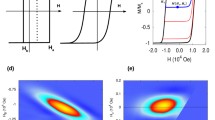Abstract
The random anisotropy model provides the theoretical basis for understanding the soft magnetic properties of amorphous and nanocrystalline ferromagnets. The arguments are surveyed, updated and illustrated in detail with the help of both an analytical model and numerical simulations. Questions how to extend the original model to a multi-phase system and how to include more uniform anisotropies are discussed. The results are related to the experimental findings for coercivity and permeability.
Access this chapter
Tax calculation will be finalised at checkout
Purchases are for personal use only
Preview
Unable to display preview. Download preview PDF.
Similar content being viewed by others
References
Herzer, G., (1997) Nanocrystalline soft magnetic alloys, in K.H.J. Buschow (ed.), Handbook of Magnetic Materials, Vol. 10, Elsevier Science, pp. 415–462.
Alben, R., Becker, J.J. and Chi, M.C., (1978) Random anisotropy in amorphous magnets, J. Appl. Phys. 49, 1653–1658.
Herzer, G., (1989) Grain structure and magnetism of nanocrystalline ferromagnets, IEEE Trans. Magn. 25, 3327–3329.
Herzer, G., (1990) Grain size dependence of coercivity and permeability in nanocrystalline ferromagnets, IEEE Trans. Magn. 26, 1397–1402
Herzer, G., (1995) Soft magnetic nanocrystalline materials, Scr. Metall. Mater. 33, 1741–1756.
Suzuki, K., Herzer, G. and Cadogan, J.M., (1998) The effect of coherent uniaxial anisot-ropies on the grain size dependence of coercivity in nanocrystalline soft magnetic alloys, J. Magn. Magn. Mater. 177–181, 949–950.
Chikazumi, S. and Charap, H., (1964) Physics of Magnetism, Robert E. Krieger Publishing Company, Malabar, Florida.
Gengnagel, H. and Wagner, H., (1961) Magnetfeldinduzierte Anisotropie an FeAl-und FeSi-Einkristallen, Z. Angew. Phys. 8, 174–177.
Iga, A., Tawara, Y., and Yanase, A., (1966) Magnetocrystalline anisotropy of Fe2B, J. Phys. Soc. Japan 21, 404.
Author information
Authors and Affiliations
Editor information
Editors and Affiliations
Rights and permissions
Copyright information
© 2005 Kluwer Academic Publishers
About this paper
Cite this paper
Herzer, G. (2005). The Random Anisotropy Model. In: Idzikowski, B., Švec, P., Miglierini, M. (eds) Properties and Applications of Nanocrystalline Alloys from Amorphous Precursors. NATO Science Series, vol 184. Springer, Dordrecht. https://doi.org/10.1007/1-4020-2965-9_2
Download citation
DOI: https://doi.org/10.1007/1-4020-2965-9_2
Publisher Name: Springer, Dordrecht
Print ISBN: 978-1-4020-2963-9
Online ISBN: 978-1-4020-2965-3
eBook Packages: Physics and AstronomyPhysics and Astronomy (R0)




